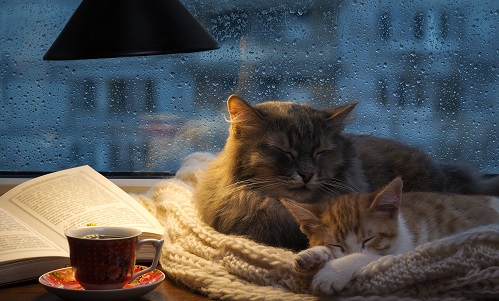So you may be wondering, are cats nocturnal? Our experts can help. Read on for useful information, including helpful insight and definitions, as well as tips and guidelines for managing this behavior.
Understanding Feline Behavior: Are House Cats Nocturnal?
Although most people would simply think of cats as nocturnal animals, it isn’t exactly accurate. In fact, domestic house cats are considered both nocturnal and crepuscular, a biological category describing animals whose primary hours of activity take place at dusk and dawn. This instinctive behavior is part of a feline’s evolution: just like his wild brethren in the jungle, domestic cats are designed by nature to take advantage of their environment when things are cool and dark. For house cats, this also entails sleeping during the day and conserving their energy for heightened nighttime activity, mimicking his ancestor’s hunting at dusk. In other words, not unlike his African wildcat ancestors, the modern-day domestic cat is hard-wired to be active at night. Below, a closer look at the two primary biological categories to better understand the different sleeping patterns of creatures within the animal kingdom – and where felines fit in:
It’s 4am and suddenly there’s a crash in the living room – an all-too-familiar scenario for house cat lovers everywhere. The family feline is on the prowl, slinking around the home (and likely making plenty of noise along the way). Maybe he’s got a fuzzy partner in crime to get into some domestic mischief – after all, what’s the point of decorations on the shelf if not to knock them off onto the floor? No matter the situation, one thing’s for certain: everyone’s awake in the household, and it probably won’t be the last time.
Diurnal
By definition, ‘diurnal’ refers to many different classes of animals, but they all share one major trait in common: they’re active during the day and rest (or have periods of inactivity) at night. Some of the most commonly-recognized diurnal animals include mammals, reptiles, and birds. Additionally, most primates are diurnal. There are numerous biological reasons why an animal may be diurnal – for example, to avoid nighttime predators. On the other hand, some animals were designed to be diurnal in order to hunt during the daylight hours, thus increasing their odds of survival. Furthermore, certain animals such as turtles require daytime activity; this is because they require sunlight in order to synthesize vitamin D3 in their bodies.
A few major examples of diurnal animals include:
- Bearded dragons
- Butterflies
- Canines
- Chimpanzees
- Chimpanzees
- Cobras
- Deer
- Dolphins
- Elephants
- Gibbons
- Gorillas
- Hawks
- Honey bees
- Humans
- Komodo dragons
- Lizards
- Monkeys
- Orangutans
- Ostriches
- Squirrels
- Turtles
- White starlings
Nocturnal
The opposite of diurnal, nocturnal animals are active during the night and sleep during the daylight hours. However, in order to adapt to the darkness, evolution has played a part in nocturnal creatures’ development – most nocturnal animals possess highly-evolved senses, including smell, hearing, and most notably, eyesight. In fact, certain animals – such as ferrets and cats – have eyes that are able to adapt to both high and low levels of illumination. Furthermore, felines also feature slit-shaped retinas, providing them with superior night vision. This heightened sight also makes it easy for felines in the wild to ambush their predators – and for domestic cats to tackle their unsuspecting owner’s feet during a 3am trip to the bathroom. Due to the unique shape of their retinas, felines are capable of lying in wait for hours in the dark in anticipation of prey. Similarly, domestic cats’ behavior hearkens the same predatory instincts: ask any pet parent and they’re sure to have at least a few stories of their rambunctious kitty stalking the shadows in the middle of the night (or just before their alarm clock goes off).
Just as diurnal animals evolved out of necessity, nocturnal animals’ sleep habits serve them for a variety of reasons. Depending on their role in the wild, they may fare better at night to elude daytime predators. In other instances, some nocturnal animals may be predisposed to activity at night because they’re natural hunters and stalk their prey at dusk.
A few primary examples of nocturnal animals include:
- Bats
- Black rats
- Catfish
- Cockroaches
- Cougars
- Coyotes
- Crickets
- Fireflies
- Gerbils
- Hyenas
- Jaguars
- Kangaroos
- Koalas
- Leopards
- Lions
- Mice
- Owls
- Porcupines
- Possums
- Scorpions
- Skunks
- Tarantulas
As illustrated above in these two primary categories, when it comes to an animal’s sleep cycles and circadian rhythms, their behaviors are determined primarily by evolution – and where an animal falls within the food chain. While domestic house cats are primarily recognized as nocturnal, they do display many crepuscular behaviors – that is, they are most active during the peak hours of dawn and dusk.
Are All Cats Nocturnal?

It’s clear that domestic house cats have taken a genetic cue from their wild cousins in the jungle – that is, their biological proclivities to be more active at night and take ample cat-naps during the day. However, even though the average housecat sleeps between 16-20 hours per day, it doesn’t necessarily mean he’ll always be a night owl – he may alternate between sleeping some nights and bouncing around the house on other occasions. And while most felines tend to be active overnight, sleep patterns vary between cats.
For example, a housecat may go to bed with his person and stay in the room til 5am, sleeping undisturbed alongside his owner. Depending on his age, health, dietary habits, behavioral traits, and even personality, some kitties are hyper at night, while others may be good sleepers. For a few lucky folks, there are cats who are pretty even-keeled when it comes to sleep habits (and not creating a commotion at night). For the less fortunate set, read on for helpful tips.





